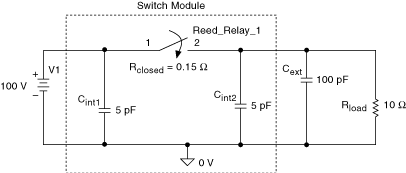Inrush Current
As current flows through the relay, power is dissipated in the contacts as represented in the following equation:
P=I2Rcontact+I2Rarc
Rarc is the resistance of the arc that exists between the relay contacts during bounce. This power dissipates as heat, raising the temperature of the contacts. Inrush currents momentarily expose the contacts to very high power levels. The energy associated with the inrush current may be sufficient to melt the contact surfaces after bouncing and weld the relay contacts closed. Inrush currents usually decrease rapidly to the steady state levels. Contact bounce, however, can subject the relay to multiple inrushes per activation, causing further damage.
The following figure shows a relay within a switch module connected to a voltage source and a load. Cint1, Cint2 and Rcontact always produce an inrush current proportional to the input voltage. The duration of the inrush current increases (as does contact heating) with the addition of external capacitance at the load. Inrush current flows while load capacitance Cint2 and Cext are being charged.
Circuit with Source and Load

Cint 2 + Cexternal = C
 = RcontactC > RcontactCint 2
= RcontactC > RcontactCint 2